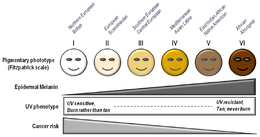Fitzpatrick scale

The Fitzpatrick scale (also Fitzpatrick skin typing test; or Fitzpatrick phototyping scale) is a numerical classification schema for human skin color. It was developed in 1975 by Thomas B. Fitzpatrick as a way to estimate the response of different types of skin to ultraviolet (UV) light.[1] It was initially developed on the basis of skin and eye color, but when this proved misleading, it was altered to be based on the patient's reports of how their skin responds to the sun; it was also extended to a wider range of skin types.[2][3][4] The Fitzpatrick scale remains a recognized tool for dermatological research into human skin pigmentation.
The following list shows the six categories of the Fitzpatrick scale in relation to the 36 categories of the older von Luschan scale:[5][6]
- Type I (scores 0–6) always burns, never tans (pale white; blond or red hair; blue eyes; freckles).
- Type II (scores 7–13) usually burns, tans minimally (white; fair; blond or red hair; blue, green, or hazel eyes)
- Type III (scores 14–20) sometimes mild burn, tans uniformly (cream white; fair with any hair or eye color)
- Type IV (scores 21–27) burns minimally, always tans well (moderate brown)
- Type V (scores 28–34) very rarely burns, tans very easily (dark brown)
- Type VI (scores 35–36) Never burns, never tans (deeply pigmented dark brown to darkest brown)
The Unicode Standard has introduced emoji modifiers, characters intended to specify the skin color of Emoji characters based on the Fitzpatrick scale, with Unicode version 8.0 (June 2015). The purpose of these modifiers is to represent racial diversity.[7][8] As of Unicode 10.0, emoji modifiers can be used with 102 human emoji spread across six blocks: Dingbats, Emoticons, Miscellaneous Symbols, Miscellaneous Symbols and Pictographs, Supplemental Symbols and Pictographs and Transport and Map Symbols.[8]
See also
References
- ↑ Fitzpatrick, T. B. (1975). "Soleil et peau" [Sun and skin]. Journal de Médecine Esthétique (in French) (2): 33–34
- ↑ Fitzpatrick, T.B. (1988), "The validity and practicality of sun-reactive skin types i through vi", Archives of Dermatology, 124 (6): 869–871, doi:10.1001/archderm.1988.01670060015008
- ↑ Pathak, M. A.; Jimbow, K.; Szabo, G.; Fitzpatrick, T. B. (1976). "Sunlight and melanin pigmentation". In Smith, K. C. (ed.): Photochemical and photobiological reviews, Plenum Press, New York, 1976: 211-239
- ↑ Fitzpatrick, T. B. (1986). "Ultraviolet-induced pigmentary changes: Benefits and hazards", Therapeutic Photomedicine, Karger, vol. 15 of "Current Problems in Dermatology", 1986: 25-38
- ↑ "The Fitzpatrick Skin Type Classification Scale". Skin Inc. (November 2007). Retrieved 7 January 2014.
- ↑ "Fitzpatrick Skin Type" (PDF). Australian Radiation Protection and Nuclear Safety Agency. Retrieved 7 January 2014.
- ↑ "UTR #51: Unicode Emoji". Unicode Consortium. 2017-05-18.
- 1 2 "UCD: Emoji Data for UTR #51". Unicode Consortium. 2017-03-27.